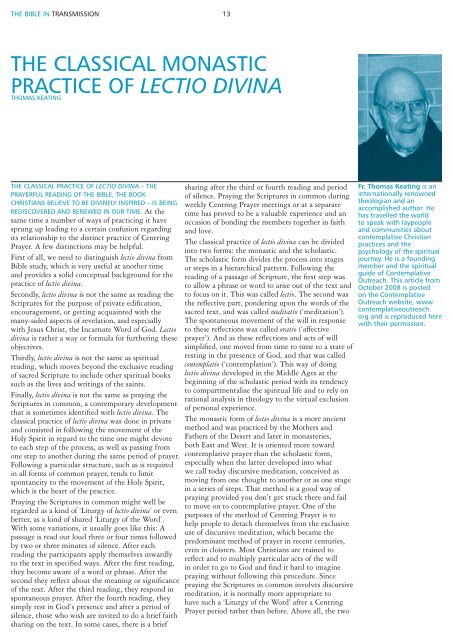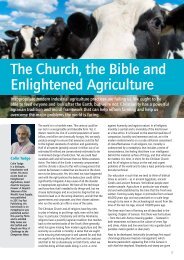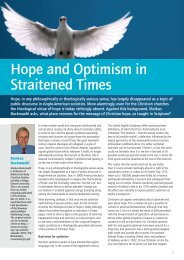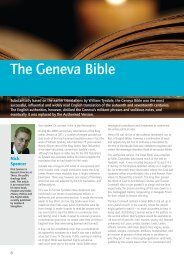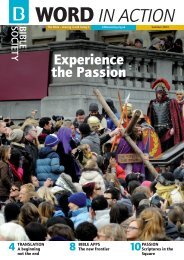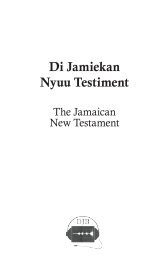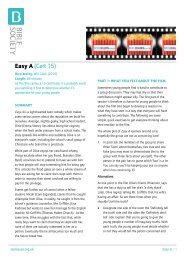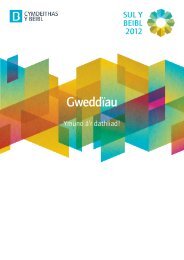the classical Monastic Practice oF LECTIo DIVINA - Bible Society
the classical Monastic Practice oF LECTIo DIVINA - Bible Society
the classical Monastic Practice oF LECTIo DIVINA - Bible Society
- No tags were found...
You also want an ePaper? Increase the reach of your titles
YUMPU automatically turns print PDFs into web optimized ePapers that Google loves.
THE BIBLE IN TRANSMISSION 13The Classical <strong>Monastic</strong><strong>Practice</strong> of Lectio DivinaThomas KeatingThe <strong>classical</strong> practice of Lectio Divina – <strong>the</strong>prayerful reading of <strong>the</strong> <strong>Bible</strong>, <strong>the</strong> bookChristians believe to be divinely inspired – is beingrediscovered and renewed in our time. At <strong>the</strong>same time a number of ways of practicing it havesprung up leading to a certain confusion regardingits relationship to <strong>the</strong> distinct practice of CentringPrayer. A few distinctions may be helpful.First of all, we need to distinguish lectio divina from<strong>Bible</strong> study, which is very useful at ano<strong>the</strong>r timeand provides a solid conceptual background for <strong>the</strong>practice of lectio divina.Secondly, lectio divina is not <strong>the</strong> same as reading <strong>the</strong>Scriptures for <strong>the</strong> purpose of private edification,encouragement, or getting acquainted with <strong>the</strong>many-sided aspects of revelation, and especiallywith Jesus Christ, <strong>the</strong> Incarnate Word of God. Lectiodivina is ra<strong>the</strong>r a way or formula for fur<strong>the</strong>ring <strong>the</strong>seobjectives.Thirdly, lectio divina is not <strong>the</strong> same as spiritualreading, which moves beyond <strong>the</strong> exclusive readingof sacred Scripture to include o<strong>the</strong>r spiritual bookssuch as <strong>the</strong> lives and writings of <strong>the</strong> saints.Finally, lectio divina is not <strong>the</strong> same as praying <strong>the</strong>Scriptures in common, a contemporary developmentthat is sometimes identified with lectio divina. The<strong>classical</strong> practice of lectio divina was done in privateand consisted in following <strong>the</strong> movement of <strong>the</strong>Holy Spirit in regard to <strong>the</strong> time one might devoteto each step of <strong>the</strong> process, as well as passing fromone step to ano<strong>the</strong>r during <strong>the</strong> same period of prayer.Following a particular structure, such as is requiredin all forms of common prayer, tends to limitspontaneity to <strong>the</strong> movement of <strong>the</strong> Holy Spirit,which is <strong>the</strong> heart of <strong>the</strong> practice.Praying <strong>the</strong> Scriptures in common might well beregarded as a kind of ‘Liturgy of lectio divina’ or evenbetter, as a kind of shared ‘Liturgy of <strong>the</strong> Word’.With some variations, it usually goes like this: Apassage is read out loud three or four times followedby two or three minutes of silence. After eachreading <strong>the</strong> participants apply <strong>the</strong>mselves inwardlyto <strong>the</strong> text in specified ways. After <strong>the</strong> first reading,<strong>the</strong>y become aware of a word or phrase. After <strong>the</strong>second <strong>the</strong>y reflect about <strong>the</strong> meaning or significanceof <strong>the</strong> text. After <strong>the</strong> third reading, <strong>the</strong>y respond inspontaneous prayer. After <strong>the</strong> fourth reading, <strong>the</strong>ysimply rest in God’s presence and after a period ofsilence, those who wish are invited to do a brief faithsharing on <strong>the</strong> text. In some cases, <strong>the</strong>re is a briefsharing after <strong>the</strong> third or fourth reading and periodof silence. Praying <strong>the</strong> Scriptures in common duringweekly Centring Prayer meetings or at a separatetime has proved to be a valuable experience and anoccasion of bonding <strong>the</strong> members toge<strong>the</strong>r in faithand love.The <strong>classical</strong> practice of lectio divina can be dividedinto two forms: <strong>the</strong> monastic and <strong>the</strong> scholastic.The scholastic form divides <strong>the</strong> process into stagesor steps in a hierarchical pattern. Following <strong>the</strong>reading of a passage of Scripture, <strong>the</strong> first step wasto allow a phrase or word to arise out of <strong>the</strong> text andto focus on it. This was called lectio. The second was<strong>the</strong> reflective part, pondering upon <strong>the</strong> words of <strong>the</strong>sacred text, and was called meditatio (‘meditation’).The spontaneous movement of <strong>the</strong> will in responseto <strong>the</strong>se reflections was called oratio (‘affectiveprayer’). And as <strong>the</strong>se reflections and acts of willsimplified, one moved from time to time to a state ofresting in <strong>the</strong> presence of God, and that was calledcontemplatio (‘contemplation’). This way of doinglectio divina developed in <strong>the</strong> Middle Ages at <strong>the</strong>beginning of <strong>the</strong> scholastic period with its tendencyto compartmentalise <strong>the</strong> spiritual life and to rely onrational analysis in <strong>the</strong>ology to <strong>the</strong> virtual exclusionof personal experience.The monastic form of lectio divina is a more ancientmethod and was practiced by <strong>the</strong> Mo<strong>the</strong>rs andFa<strong>the</strong>rs of <strong>the</strong> Desert and later in monasteries,both East and West. It is oriented more towardcontemplative prayer than <strong>the</strong> scholastic form,especially when <strong>the</strong> latter developed into whatwe call today discursive meditation, conceived asmoving from one thought to ano<strong>the</strong>r or as one stagein a series of steps. That method is a good way ofpraying provided you don’t get stuck <strong>the</strong>re and failto move on to contemplative prayer. One of <strong>the</strong>purposes of <strong>the</strong> method of Centring Prayer is tohelp people to detach <strong>the</strong>mselves from <strong>the</strong> exclusiveuse of discursive meditation, which became <strong>the</strong>predominant method of prayer in recent centuries,even in cloisters. Most Christians are trained toreflect and to multiply particular acts of <strong>the</strong> willin order to go to God and find it hard to imaginepraying without following this procedure. Sincepraying <strong>the</strong> Scriptures in common involves discursivemeditation, it is normally more appropriate tohave such a ‘Liturgy of <strong>the</strong> Word’ after a CentringPrayer period ra<strong>the</strong>r than before. Above all, <strong>the</strong> tw<strong>oF</strong>r. Thomas Keating is aninternationally renowned<strong>the</strong>ologian and anaccomplished author. Hehas travelled <strong>the</strong> worldto speak with laypeopleand communities aboutcontemplative Christianpractices and <strong>the</strong>psychology of <strong>the</strong> spiritualjourney. He is a foundingmember and <strong>the</strong> spiritualguide of ContemplativeOutreach. This article fromOctober 2008 is postedon <strong>the</strong> ContemplativeOutreach website, www.contemplativeoutreach.org and is reproduced herewith <strong>the</strong>ir permission.
BIBLE SOCIETY 14‘we break through <strong>the</strong> veil of ourown ways of thinking. The externalword of God in Scripture awakensus to <strong>the</strong> interior Word of God inour inmost being’upractices should not be combined because each hasits own integrity and uniqueness.In <strong>the</strong> monastic way of doing lectio divina we listento how God is addressing us in a particular text ofScripture. From this perspective <strong>the</strong>re are no stages,ladders or steps in lectio divina, but ra<strong>the</strong>r <strong>the</strong>re arefour moments along <strong>the</strong> circumference of a circle. All<strong>the</strong> moments of <strong>the</strong> circle are joined to each o<strong>the</strong>rin a horizontal and interrelated pattern as well as to<strong>the</strong> centre, which is <strong>the</strong> Spirit of God speaking to usthrough <strong>the</strong> text and in our hearts. To pay attentionto any one of <strong>the</strong> four ‘moments’ is to be in directrelationship to all <strong>the</strong> o<strong>the</strong>rs. In this perspective, onemay begin one’s prayer at any ‘moment’ along <strong>the</strong>circle, as well as moving easily from one ‘moment’ toano<strong>the</strong>r, according to <strong>the</strong> inspiration of <strong>the</strong> Spirit.Paul writes, ‘Don’t you know that you yourselves areGod’s temple and that God’s Spirit lives in you?’(1 Cor 3.16). Suppose you were struck by thatquestion as you are reading a section of yourScripture reading for <strong>the</strong> day, say a dozen or soverses, and you felt nudged to let your attentionlinger over those words to savour <strong>the</strong>m. The earlymonks read Scripture aloud so <strong>the</strong>y were actuallylistening to it. They would <strong>the</strong>n choose a phrase, ora sentence at <strong>the</strong> most, that impressed <strong>the</strong>m. Theywould sit with that sentence or phrase withoutthinking of stages or following some predeterminedschema, but just listening, repeating slowly <strong>the</strong>same short text over and over again. This receptivedisposition enabled <strong>the</strong> Holy Spirit to expand <strong>the</strong>ircapacity to listen. As <strong>the</strong>y listened, <strong>the</strong>y mightperceive a new depth to <strong>the</strong> text or an expandingmeaning. A particular insight might also besingularly appropriate for <strong>the</strong>m in <strong>the</strong>ir particularlife situation or for <strong>the</strong> events of <strong>the</strong> coming day.According to Scripture, <strong>the</strong> Spirit speaks to us everyday: ‘Today, if you hear his voice, do not hardenyour hearts’ (Ps 95.7–8). The monks listened not somuch to understand <strong>the</strong> text, not to conceptualise oranalyze it, but just to hear it. And to hear it withoutany preconceived purpose of what <strong>the</strong>y were going todo with it.This is already a deep form of receptivity. Thosewho practice lectio divina in this way are alreadymoving toward <strong>the</strong> fourth ‘moment’ of this dynamicprocess leading to resting in God. In response toa new insight, <strong>the</strong>y might be inclined to respondin thanksgiving or with interior movements oflove, praise or gratitude. As this listening attitudestabilises, <strong>the</strong>y might experience moments ofcontemplative prayer in <strong>the</strong> strict sense, in which<strong>the</strong>y are just present to God, or quietly engulfedin <strong>the</strong> divine presence. In this situation, one’sattentiveness to God expands into <strong>the</strong> sheerawareness of <strong>the</strong> divine presence. For <strong>the</strong> moment,we break through <strong>the</strong> veil of our own ways ofthinking. The external word of God in Scriptureawakens us to <strong>the</strong> interior Word of God in ourinmost being. When that awareness dissipates, wemay go back and read more of <strong>the</strong> text, provided, ofcourse, we have <strong>the</strong> time.This monastic way of doing lectio divina alwaysbegins with prayer to <strong>the</strong> Holy Spirit. The fourmoments along <strong>the</strong> circumference of <strong>the</strong> circle arereading in <strong>the</strong> presence of God, reflecting in <strong>the</strong>sense of ruminating (not in <strong>the</strong> sense of discursivemeditation), responding with spontaneous prayer,and resting in God beyond thoughts and particularacts of <strong>the</strong> will.By ‘ruminating’ I mean sitting with a sentence,phrase or even one word that emerges from <strong>the</strong> text,allowing <strong>the</strong> Spirit to expand our listening capacityand to open us to its deeper meaning; in o<strong>the</strong>rwords, to penetrate <strong>the</strong> spiritual sense of a Scripturepassage. This leads to <strong>the</strong> faith experience of <strong>the</strong>living Christ and increases <strong>the</strong> practical love foro<strong>the</strong>rs that flows from that relationship.As we repeat <strong>the</strong> phrase or sentence slowly, overand over, a deeper insight may arise. For example,take <strong>the</strong> words of Jesus, ‘I will not call you servantsbut friends’ (Jn 15.15). All of a sudden, it mightdawn on us what it means to be a friend of Christ.Our awareness expands without our having doneanything but allow <strong>the</strong> Spirit to act. It is a heart-toheartexchange with Christ. We think <strong>the</strong> text butwe do not think about <strong>the</strong> text. If we are thinkingin <strong>the</strong> sense of reflecting, we are dominating <strong>the</strong>conversation. That can be done fruitfully some o<strong>the</strong>rtime. Here it is a question of receiving and resting inChrist’s presence as <strong>the</strong> source of <strong>the</strong> word or phrase.Lectio divina is a special kind of process, and tobenefit fully from its fruits, its integrity has to berespected. The ripe fruit of <strong>the</strong> regular practice oflectio divina is assimilating <strong>the</strong> word of God andbeing assimilated by it. It is a movement fromconversation to communion. It also enables us toexpress our deep spiritual experience of union withGod in words or symbols that are appropriate. There
THE BIBLE IN TRANSMISSIONis thus a movement not only into silence, but fromsilence to expression.In <strong>the</strong> Trinity, <strong>the</strong> Eternal Word is always emergingfrom <strong>the</strong> infinite silence of <strong>the</strong> Fa<strong>the</strong>r and alwaysreturning. The persons in <strong>the</strong> Trinity live in eacho<strong>the</strong>r ra<strong>the</strong>r than in <strong>the</strong>mselves. The Fa<strong>the</strong>r knowshimself only in <strong>the</strong> Son, <strong>the</strong> Son only in <strong>the</strong> Fa<strong>the</strong>rand <strong>the</strong> Spirit expresses <strong>the</strong>ir unity, bringingtoge<strong>the</strong>r into One relationships that are infinitelydistinct. The Trinity is <strong>the</strong> basis for <strong>the</strong> oneness anddiversity that we see expressed throughout creation.In this way of doing lectio divina, one is recognizing<strong>the</strong> presence of <strong>the</strong> Word of God in all creation andin every occurrence, experiencing what <strong>the</strong> authorof John’s Gospel wrote in <strong>the</strong> prologue, ‘WithoutHim was made nothing that has been made.’ Incontemplative prayer, we are in touch with <strong>the</strong>source of all creation; hence, we transcend ourselvesand our limited worldviews. As a result, we feel atone with o<strong>the</strong>r people and enjoy a sense of belongingto <strong>the</strong> universe. The fullness of <strong>the</strong> Godhead dwellsbodily in Jesus, according to Paul. The Divinitybegins to dwell in us bodily in proportion to ourcapacity to receive it as we grow in union with <strong>the</strong>Eternal Word. This process needs to be nourishedboth by <strong>the</strong> interior silence of contemplative prayerand cultivated by lectio divina (in <strong>the</strong> sense oflistening). The awareness of <strong>the</strong> divine presence willalso begin to overflow into ordinary activity.The scholastic method is a good way to learn lectiodivina whe<strong>the</strong>r privately or in a group. The monasticmethod is oriented more toward contemplativeprayer and from <strong>the</strong> start resting in God byestablishing us in a listening attitude. The dynamicinteraction between <strong>the</strong> four ‘moments’ of lectioreading,reflecting in <strong>the</strong> sense of ruminating on aparticular word or phrase, responding in prayer, andresting in God puts us more and more at <strong>the</strong> disposalof <strong>the</strong> Holy Spirit. n


